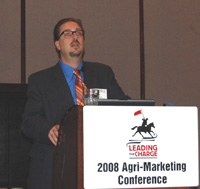Cellulosic ethanol is no longer a pipe dream. It’s real and it is being produced today.
That was the message Tom Slunecka, Vice President of Business Development for KL Process Design Group of South Dakota, gave at the 2008 Agri-Marketing Conference in Kansas City last week. Slunecka provided a detailed overview of the state of cellulosic ethanol to agri-marketers during a conference breakout session that included just what cellulosic is and what the future holds.
 KL Process Design Group was the first company to get a small-scale cellulosic ethanol plant on-line using waste-wood material to produce about 1.5 million gallons of ethanol a year. The company is currently providing teams in the American LeMans Series with an 85 percent cellulosic ethanol racing fuel.
KL Process Design Group was the first company to get a small-scale cellulosic ethanol plant on-line using waste-wood material to produce about 1.5 million gallons of ethanol a year. The company is currently providing teams in the American LeMans Series with an 85 percent cellulosic ethanol racing fuel.
“Currently there are three different teams, four different cars running,” said Slunecka. “We have two Corvettes, we have a prototype car and we have an Aston Martin, all running on E85R cellulosic race fuel.”
Slunecka explained that there are several different processes that can be used to convert biomass into biofuels. “Our process is a heat and mechanical pre-treatment process. There is a biochemical process, there is a syngas process, and then there are combinations of all the above,” he said. “There is no silver bullet. We’re gonna need them all to produce the amount of fuel that is needed.”
And that would be the amount of cellulosic ethanol required under the energy bill passed by Congress last year. “The Renewable Fuels Standard does require that we have over 21 billion gallons of renewable fuels created from biomass over the next ten years,” said Slunecka, a goal he says is a high hurdle, but does provide incentive for investors to put money into the development of these fuels.
Slunecka also talked about the potential for the type of small-scale plant his company has designed to be created by adding a wood processing component on to the front end of a traditional corn ethanol plant, or adding a traditional corn ethanol-type component on to the back end of an existing wood processing plant.
In addition, Slunecka says one of the unique factors in KL’s process design is that it creates two different by-products that have very high value. “One is a very high protein syrup that can be used as a feed supplement or can be burned in biomass burners,” he said. “The other is a product called lignin, which is leftover from plants after the sugar has been removed.” Lignin has a variety of uses, from burning for energy to a basis for paints and cosmetics.
Listen to an interview with Tom Slunecka here:
[audio:http://www.zimmcomm.biz/nama/nama-slunecka.mp3]

